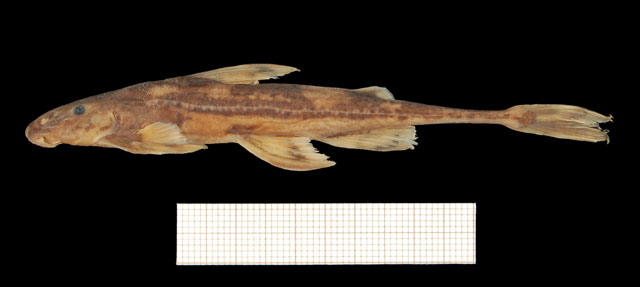|
Dorsal spines (total): -0; Anal spines: -0. Diagnosis: distinct gap between supraoccipital process and nuchal shield greater than width of supraoccipital process; postorbit 50-60% snout length; caudal peduncle long, 3.4-3.6 times in SL, slender, length 8.7-11.1 times depth, and bony (Ref. 81646).
Description: body firm, slender, moderately depressed, strongly tapered to caudal base; mid-dorsal ridge from dorsal to adipose, thin bi-lateral ridges along caudal peduncle; skin smooth, or in larger individuals head and upper body covered with short vermiculate white unculi; head short 4.8-5.5 times in SL, obtusely pointed, flat below, rounded above; snout longer than postorbit, 1.5-1.9 times in HL; nostrils separated, on anterior half of snout; mouth ovoid, ventral, upper lips fleshy and papillose, lower lip divided by medial triangular pad; barbels short, maxillary pair longest, less than 66% HL, tapered, papillose; eyes small, orbits bony, widely separated by distance 1.9-2.4 times orbit diameter; supraoccipital process slender, half length of snout, separated from nuchal shield by gap; obscure short humeral process above gill openings; branchiostegal membrane united ventrally, margin with shallow medial notch; fins large and pointed; origin of dorsal less than one head length behind head; dorsal fin entirely in advance of pelvics, pointed with concave hind margin; pectorals falcate, not reaching bases of pelvics, leading ray curved, pectinate and padded, outer rays lie horizontal, inner rays vertical against body; pelvic fins falcate, reaching base of anal, leading ray curved, pectinate and padded; anal fin large, trailing edge straight; caudal with compact base forked with ventral lobe slightly longer than dorsal; adipose fin triangulate over posterior base of anal; ano-genital pores mid-way between pelvic bases and origin of anal; males with conical genital papilla (Ref. 81646).
Coloration: dark brown above, light cream below; flanks light brown; lateral line highlighted in cream; head with dark pre-orbital stripes and light patches above, a series of 5-6 lighter saddles along back, dark brown patches above pelvic fin bases; fins with brown rays and dark mid-distal band; outer rays of caudal brown (Ref. 81646). |

